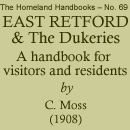< Previous | Contents | Next >
(b) To Cannon Square and North Retford.
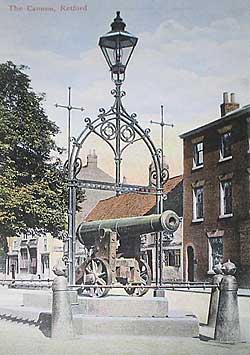
The canon, Canon Square, East Retford.
Leaving the parish church by the principal entrance gates, we enter Cannon Square, which is near to the Market-place. Branching from it eastwards are (1) Churchgate and Moorgate; and (2) Chapel Gate and Spital Hill. The cannon, whence the name is derived, mounted on a couple of stone steps, surrounded by an iron palisading, and surmounted by an ornamental lamp, was captured during the Crimean War. It is a 24-pounder, 7 feet 1 in. long, weighs 2 tons, 11 cwts., and was brought to Retford in 1859. On Moorgate Hill is St. Saviour's Church, auxiliary to the mother church of St. John's, Clarborough, with nave, chancel, and two side aisles (1828). On October 25th, 1859, the Rev. C. Hodge, Vicar of Clarborough, perished in the wreck of the Royal Charter, on the coast of the Isle of Anglesey, on his return from New Zealand. Recently eight tubular bells have been added to this church in place of the single bell previously existing.
In Chapelgate, on the site of the East Retford Vicarage grounds, stood the old Grammar School, which was taken down on the completion of the new building (1854). The Free Methodist Church here was built in 1878-9. It replaced the old one which had been previously occupied, first by the followers of the Countess of Huntingdon, and afterwards by the Independents. On the north side of Spital Hill stood the Revolution Mill, 1788, for the manufacture of worsted, of which the originator was Major Cartwright, a candidate for the representation of the borough in Parliament. It was named in commemoration of the English Revolution in 1688, and in sympathy with the French Revolution then dawning. It cost £25,000 and employed between 600 and 700 hands. The enterprise failed, and the mill and its contents were sold.
(c) To Bridgegate and West Retford.
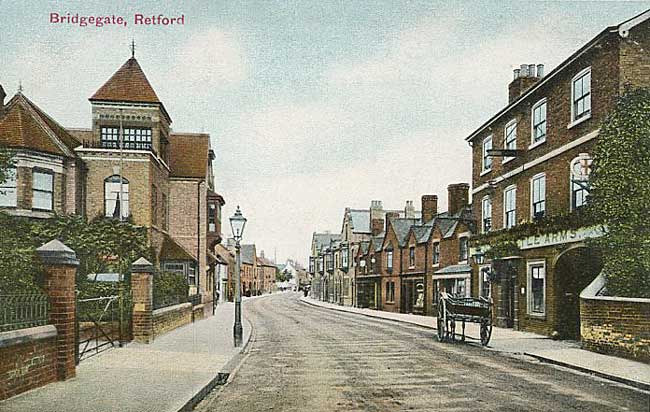
Bridgegate, Retford.
From the Market-place we enter at once into Bridgegate on the great North Road. This is the oldest part of the town, coeval with its establishment. Many of the dead and gone celebrities lived here, including Roger Godde, the first representative of the borough in Parliament (temp. Edward II., 1315). At the entrance, abutting also on the Market-place, is the White Hart Hotel, (which has been in the family of the present owner for three generations), famous in the coaching days, equally famous in these modern times.
A few yards further is the principal post office. There are now four deliveries of letters daily. Within living memory the letters were distributed by one woman, "Old Betty Chapman." When the Great North Road passed through Sherwood Forest, they were left at Rushy Inn. Upon the diversion of the road through Retford (1766) they were carried from Tuxford on foot, and it was not until the establishment of mail coaches that they were brought here direct. At one time (1820), on the site of the Post Office there was a large felt hat manufactory.
Opposite to the Post Office is a yard or narrow street, which leads down to the River Idle. Here the ducking-stool, the use of which was granted in 1279 by Edward I., was used in 1760 for the last time. A Scotswoman, of violent temperament, usually called "Dame Barr," had offended John White, a gentleman of some position, by throwing the contents of her snuff-box in his face, and uttering opprobrious terms. She was brought to this identical spot, placed in the ducking-stool, and ducked. A score of yards west of the Post Office is West Retford Bridge. This bridge spans the river Idle, and divides East and West Retford. It was erected in 1868, at a cost of £1,500. The original structure was of wood. In 1659 a stone bridge was erected, thirteen feet wide, with five arches. In 1794 its width was extended to thirty-one feet, and it was made eighteen feet longer. Previous to 1776 a toll was demanded here from all persons entering the town. The vacant land adjoining the bridge on the north side was occupied by the corn mills, mentioned in Domesday Book. These were once owned by Hubert de Burgh, the great warrior and statesman, who is introduced by Shakespeare in King John.
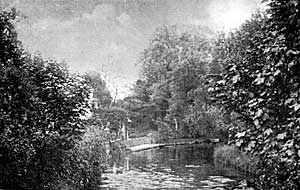
The River Idle, from West Retford bridge.
The name of the river is derived from "Ie" and "Ea" (Saxon), meaning running water. The last syllable "dle" is a corruption of "dale"; thus "Iedale," or dale of the running water, by abbreviation "Idle," and applied to the river itself. We have the village of "Ea-ton" or water town, close by. Ordsall, Retford, Lound, Mattersey, etc., are all in "Iedale."
On November 23rd, 1719, the corporation obtained an Act to make the river Idle navigable from East Retford to the river Trent at Stockwith. That Act is in existence, unrepealed. It proved an abortion, which was not surprising. Thirteen individuals, whose whole property amounted to less than £10,000, committed themselves to an undertaking which was to cost £200,000. All the corporation did was to build the lock at Bolham in 1720. In that year the scheme was abandoned, and the Act became a dead letter.
West Retford is beyond the bridge. West Retford, "contains 953 acres of land," of which the greater part belongs to the Trinity Hospital. It was brought within the jurisdiction of the borough by the Act of 1878. Anciently it belonged to Roger de Busli, of the great northern house of Montgomery, apparently a great favourite of the Conqueror. In Nottinghamshire alone he had 174 manors. Sir John Hercy, who owned the manor of West Retford subsequently, settled it upon his sister, Anne Denman. In this family it remained until Barbara Denman (daughter and co-heiress of Francis), married Edward Darrel, the last of whose descendants John Darrel, B.A. (Oxon), M.D., who died in 1665, founded and endowed the Trinity Hospital.
A few yards from the bridge, upon the wall of a dwelling house, within folding doors which lead to the back entrance, is an inscription, which states that, in an orchard "on this site" on the evening of June 24th, 1786, a sermon was preached by the Rev. John Wesley, M.A., from the words "I saw the small and great stand before God." In West Retford are a Baptist tabernacle and manse, built 1871-72. Here too are the playing-fields of the borough:—the many-acred cricket and football grounds; the bowling green, and the tennis courts. From West Retford there is a most enjoyable stroll by the banks of the Idle, over the meadows to the hamlet of Bolham, still in the borough—a romantic spot, the walk down to the rifle butts by the side of the river being full of charm. (Return by way of Tiln Road into Moorgate).
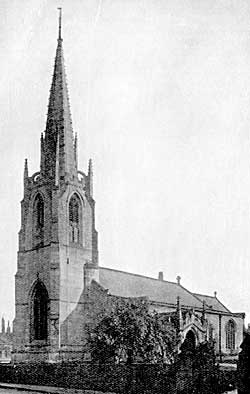
The Church of St. Michael, West Retford.
The church, [Open all day] dedicated to St. Michael, was founded early in the thirteenth century. For a hundred and fifty years the advowson belonged to the corporation of East Retford, but it is now in private hands. The church consists of nave, north and south aisles, chancel, and a north transept which contains the organ. The tower is decorated with an open parapet and pinnacles, whence springs a spire, which Pugin, the great architect, described as a "poem in stone." Tower and spire are similar to those of the church of Laughton-en-le-Morthen, and both are of like design to the church of St. Pierre, Caen, Normandy. The south porch, recently restored, affords a fine example of a stone groined roof. The north aisle was added at the restoration in 1864. In 1889 the then rector (the Rev. Watkin Homfrey) lengthened the chancel. Upon his decease the chancel screen of oak was erected to his memory. In olden times, the south aisle formed a separate chapel, distinct from the nave, called the mediety of St. Oswald, with its own rector. Upon one of the pillars of the south aisle will be noticed a statuette of St. Oswald, recently erected. Other noteworthy features are:—the reredos of alabaster, in memory of William Overend, Q.C.; and a cover to the font, of carved oak, of beautiful and elaborate design. There are several stained windows commemorative of distinguished parishioners, and one to the founder of the Hospital.
